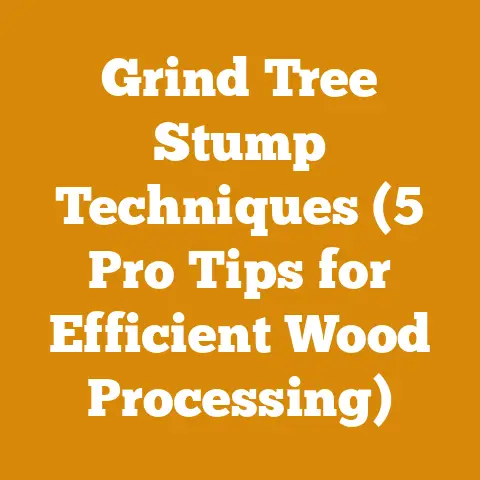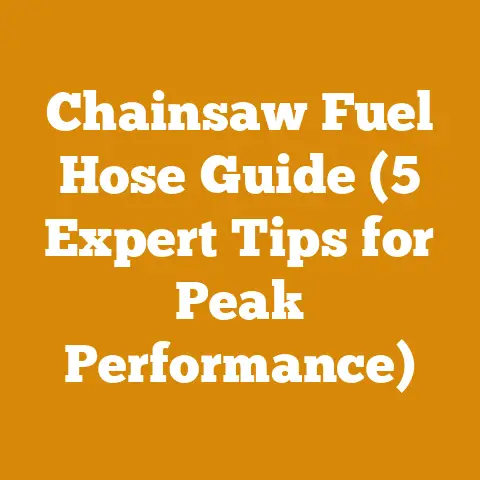Stump Grinding Rates (5 Pro Tips for Accurate Pricing)
Why did the tree break up with the lumberjack? Because he couldn’t commit to the relationship; he was always splitting!
Alright folks, let’s talk stump grinding. It’s a task that can transform your yard from an obstacle course back into a green oasis. But, like any home improvement project, understanding the costs involved is crucial. So, let’s dive into the world of stump grinding rates and how to get accurate pricing.
Stump Grinding Rates: 5 Pro Tips for Accurate Pricing
Stump grinding, at its core, is the process of removing tree stumps using specialized machinery. It’s often necessary after tree removal to eliminate tripping hazards, prevent regrowth, and reclaim usable space in your yard. But the cost can vary wildly, depending on several factors. I’ve seen estimates that were laughably low and others that seemed to be pulled from thin air. These tips will help you navigate the process and ensure you get a fair price.
1. Understand the Factors That Influence Stump Grinding Costs
Before you even start calling for quotes, it’s essential to understand what drives the price of stump grinding. It’s not as simple as just “removing a stump.” Several elements come into play:
- Stump Size: This is the most obvious factor. Larger stumps require more time, effort, and machine power to grind. I’ve seen tiny sapling stumps that take minutes and behemoths that require a full day’s work. The diameter is usually measured at ground level.
- Stump Quantity: If you have multiple stumps, the overall cost will increase. However, you might be able to negotiate a better rate per stump if you have several to be ground.
- Stump Accessibility: Can the stump grinder easily reach the stump? Are there fences, buildings, or other obstacles in the way? Difficult access can significantly increase the labor time and, therefore, the cost. I once had to remove a section of fence just to get a grinder to a remote stump in a backyard.
- Stump Age and Wood Density: Freshly cut stumps are generally easier to grind than old, decaying ones. The wood in older stumps can become incredibly hard and dense, especially if it’s a hardwood species like oak or maple. Species also plays a role. Pine stumps, for instance, are usually softer than oak.
- Root System: The extent of the root system also affects the price. Some trees have shallow, spreading roots, while others have deep, extensive networks. Grinding the visible stump is only part of the job; the larger the root system, the more grinding required.
- Location: Prices vary regionally. Stump grinding in a densely populated urban area with high labor costs will likely be more expensive than in a rural area with lower overhead.
- Debris Removal: Does the quote include removal of the wood chips and debris generated during the grinding process? This can be an additional cost. I’ve had clients who wanted to keep the chips for mulch, which saved them money.
- Permits and Regulations: In some areas, permits may be required for stump grinding, especially if it’s near public utilities or if the work involves disturbing a significant amount of soil. These permit fees will be added to the overall cost.
- Underground Obstacles: Are there underground utilities, sprinkler systems, or buried rocks near the stump? These can pose a risk to the grinding equipment and increase the complexity of the job, potentially raising the price.
- Travel Time: Some companies charge for travel time, especially if the job is located far from their base of operations.
Data & Statistics: According to a survey conducted by HomeAdvisor, the national average cost for stump grinding ranges from $160 to $380 per stump. However, this is just an average; the actual cost can vary significantly based on the factors mentioned above.
2. Understanding Pricing Structures: Per-Stump, Per-Hour, and Per-Day
Stump grinding services typically offer three main pricing structures:
-
Per-Stump Pricing: This is the most common pricing method, especially for residential jobs. The contractor assesses the stump and provides a fixed price for its removal. This is often the easiest to budget for, as you know the exact cost upfront. However, make sure the quote is detailed and specifies what’s included (e.g., debris removal, grinding depth).
- Example: A contractor might charge $100 for a small stump (under 12 inches in diameter), $200 for a medium stump (12-24 inches), and $300+ for a large stump (over 24 inches).
-
Per-Hour Pricing: Some contractors charge an hourly rate for stump grinding. This is more common for larger jobs or when the stump is particularly difficult to access or grind. Hourly rates can vary widely depending on the contractor’s experience, equipment, and location.
-
Example: An hourly rate might range from $100 to $200 per hour. Be sure to ask for an estimate of the total time required to complete the job.
-
Per-Day Pricing: This is typically used for very large jobs involving multiple stumps or extensive root systems. A daily rate offers a fixed cost for a full day’s work. This can be a good option if you have a lot of stumps to grind.
-
Example: A daily rate might range from $800 to $1500 per day.
When to Choose Which Structure:
- Per-Stump: Best for single stumps or small projects where the scope is well-defined.
- Per-Hour: Suitable for complex jobs or when the stump’s difficulty is uncertain. Get a time estimate beforehand!
- Per-Day: Ideal for large-scale projects with multiple stumps or extensive grinding needs.
Data & Statistics: According to data from Angie’s List, hourly rates for stump grinding can range from $100 to $250, depending on the region and the complexity of the job. Per-day rates can vary from $800 to $1,800.
3. Getting Multiple Quotes and Comparing Apples to Apples
This is a golden rule for any home improvement project, and stump grinding is no exception. Getting multiple quotes allows you to compare prices and services offered by different contractors. Don’t just go with the lowest bid; consider the contractor’s experience, reputation, and the details of their quote.
How to Get Accurate Quotes:
- Provide Detailed Information: Be as specific as possible when describing the stump(s) to the contractors. Include the diameter, species (if known), accessibility, and any potential obstacles.
- Ask for a Written Quote: Always get a written quote that clearly outlines the scope of work, the price, and any additional fees.
- Inquire About Insurance and Licensing: Make sure the contractor is properly licensed and insured. This protects you in case of accidents or damage to your property.
- Check References and Reviews: Ask for references from previous clients and check online reviews to get an idea of the contractor’s reputation.
- Clarify Debris Removal: Find out if the quote includes debris removal. If not, ask for a separate price for this service.
- Confirm Grinding Depth: Clarify how deep the stump will be ground. Generally, it should be ground at least 6-12 inches below the surface to allow for replanting or landscaping.
- Discuss Potential Additional Costs: Ask about any potential additional costs that might arise, such as the need to remove roots or deal with underground obstacles.
Comparing Quotes:
When comparing quotes, make sure you’re comparing apples to apples. Consider the following:
- Scope of Work: Does each quote include the same services (e.g., debris removal, grinding depth)?
- Price: Is the price per stump, per hour, or per day?
- Experience and Reputation: Does the contractor have a good track record?
- Insurance and Licensing: Are they properly insured and licensed?
- Payment Terms: What are the payment terms? Do they require a deposit?
Personal Anecdote: I once hired a stump grinder based solely on the lowest quote. Big mistake! They showed up with inadequate equipment and ended up damaging my lawn. I learned my lesson: price isn’t everything; experience and reputation matter.
4. Negotiating the Price: Strategies for a Better Deal
Negotiation is a key part of getting a good price on stump grinding. Don’t be afraid to haggle, especially if you have multiple stumps or if you’re willing to be flexible with the scheduling.
Negotiation Strategies:
- Bundle Services: If you need other tree services, such as tree removal or pruning, consider bundling them with stump grinding to get a better overall price.
- Offer Flexibility: If you’re flexible with the scheduling, you might be able to get a discount. Contractors often have slow periods or cancellations, and they might be willing to offer a lower price to fill those slots.
- Ask for a Discount: Simply ask if they offer any discounts, such as senior citizen discounts or discounts for multiple stumps.
- Provide Assistance: If you’re willing to help with debris removal or other tasks, you might be able to negotiate a lower price.
- Highlight Competitor Quotes: If you have lower quotes from other contractors, use them as leverage to negotiate a better price.
- Pay in Cash: Some contractors offer discounts for cash payments.
- Consider Off-Season Grinding: Demand for stump grinding is often lower in the off-season (winter or early spring), so you might be able to get a better price during these times.
Important Considerations:
- Be Respectful: Be respectful and professional when negotiating. Don’t try to lowball the contractor or be overly aggressive.
- Know Your Budget: Have a clear idea of your budget before you start negotiating.
- Be Willing to Walk Away: If you can’t reach an agreement on price, be willing to walk away. There are plenty of other stump grinding services out there.
Data & Statistics: According to a report by Consumer Reports, consumers who negotiate prices for home improvement projects save an average of 5-10%.
5. DIY vs. Hiring a Professional: Weighing the Pros and Cons
The final decision is whether to tackle the stump grinding yourself or hire a professional. While DIY might seem cheaper upfront, it’s important to consider the risks and challenges involved.
DIY Stump Grinding:
- Pros:
- Lower upfront cost (rental fees for the equipment)
- Flexibility to work at your own pace
- Sense of accomplishment
- Cons:
- Requires physical strength and stamina
- Can be dangerous if not done properly
- Rental equipment can be expensive
- Time-consuming
- Potential for property damage
- Limited grinding depth with some rental machines
Hiring a Professional:
- Pros:
- Experience and expertise
- Proper equipment
- Faster and more efficient
- Less risk of injury or property damage
- Insurance coverage
- Cons:
- Higher upfront cost
- Less control over the process
- Need to vet contractors carefully
When to DIY:
- Small stumps (under 12 inches in diameter)
- Easy access to the stump
- Experience operating machinery
- Physical fitness and stamina
- Budget constraints
When to Hire a Professional:
- Large or multiple stumps
- Difficult access to the stump
- Lack of experience or physical fitness
- Concerns about safety
- Desire for a professional finish
Cost Comparison:
- DIY: Renting a stump grinder can cost anywhere from $75 to $200 per day, depending on the size and power of the machine. You’ll also need to factor in the cost of fuel, safety equipment (gloves, eye protection), and any potential repairs.
- Professional: As mentioned earlier, the average cost for professional stump grinding ranges from $160 to $380 per stump.
Personal Experience: I’ve tried DIY stump grinding once, and let me tell you, it was a humbling experience. The machine was heavy and difficult to maneuver, and I ended up spending an entire weekend grinding a single stump. In the end, I probably would have saved time and money by hiring a professional.
Safety First: If you decide to DIY, make sure you wear appropriate safety gear, including eye protection, hearing protection, gloves, and sturdy boots. Read the equipment manual carefully and follow all safety instructions. Be aware of underground utilities and potential hazards.
Additional Cost Factors to Consider
Beyond the core factors, several other elements can influence the final cost of stump grinding. Overlooking these can lead to unexpected expenses and budget overruns.
Wood Species and Density
The type of tree and its wood density significantly impact grinding time and cost. Hardwoods like oak, maple, and hickory are much denser than softwoods like pine, fir, or cedar. Grinding a hardwood stump requires more power, more time, and more wear and tear on the grinding equipment.
- Hardwoods: Expect higher grinding costs for hardwoods due to their density. The contractor may need to use specialized grinding teeth or make multiple passes to remove the stump effectively.
- Softwoods: Softwood stumps are generally easier and faster to grind, resulting in lower costs.
- Rotten Wood: Surprisingly, heavily decayed wood can sometimes be more challenging to grind than solid wood. The soft, spongy texture can clog the grinding teeth and slow down the process.
Data & Statistics: According to the USDA Forest Service, the density of hardwoods can range from 40 to 70 pounds per cubic foot, while the density of softwoods typically ranges from 25 to 40 pounds per cubic foot.
Root System Complexity
The extent and complexity of the root system are crucial cost factors. Some trees have shallow, spreading roots, while others have deep, extensive networks. Grinding the visible stump is only part of the job; the larger the root system, the more grinding required.
- Surface Roots: Trees with prominent surface roots, like maples or elms, can be more time-consuming to grind. The contractor may need to expose and grind these roots individually.
- Taproots: Trees with deep taproots, like oaks or hickories, require deeper grinding to remove the entire root system.
- Root Sprouts: Some trees, like aspens or willows, are prone to sending up root sprouts after the stump is ground. This can require additional treatment to prevent regrowth.
How to Assess Root System Complexity:
- Observe the surrounding area: Look for surface roots extending from the stump.
- Consider the tree species: Research the typical root system of the tree species.
- Ask the contractor: Discuss the potential extent of the root system with the contractor and get an estimate of the additional cost for grinding the roots.
Soil Conditions
The type of soil surrounding the stump can also affect grinding costs. Rocky or sandy soil can dull the grinding teeth and slow down the process. Wet or muddy soil can make it difficult to maneuver the grinding equipment.
- Rocky Soil: Grinding in rocky soil can damage the grinding teeth and increase the risk of flying debris. The contractor may need to take extra precautions to protect themselves and the surrounding area.
- Sandy Soil: Sandy soil can be abrasive and can quickly dull the grinding teeth.
- Clay Soil: Clay soil can become sticky and difficult to work with when wet.
- Wet Soil: Wet or muddy soil can make it difficult to maneuver the grinding equipment and can increase the risk of the machine getting stuck.
Mitigating Soil Condition Challenges:
- Dry the Area: If possible, try to dry out the area around the stump before the grinding process.
- Remove Rocks: Remove any visible rocks or debris from the surrounding area.
- Inform the Contractor: Inform the contractor about the soil conditions so they can prepare accordingly.
Obstacles and Accessibility
As mentioned earlier, obstacles and accessibility are major cost drivers. Anything that makes it difficult to access the stump or maneuver the grinding equipment will increase the labor time and, therefore, the cost.
- Fences: Fences may need to be removed or temporarily taken down to allow access to the stump.
- Buildings: Stumps located close to buildings can be challenging to grind without damaging the structure.
- Underground Utilities: Underground utilities (gas lines, water pipes, electrical cables) pose a significant risk during stump grinding. It’s crucial to locate and mark these utilities before starting the work. Call 811 before you dig.
- Sprinkler Systems: Sprinkler systems can be damaged during stump grinding. It’s important to locate and mark these systems before starting the work.
- Slopes and Hills: Stumps located on steep slopes or hills can be difficult to access and grind safely.
Addressing Obstacles and Accessibility Issues:
- Clear the Area: Clear the area around the stump of any obstacles, such as fences, rocks, or debris.
- Locate Utilities: Call 811 to locate and mark any underground utilities.
- Inform the Contractor: Inform the contractor about any obstacles or accessibility issues so they can plan accordingly.
Debris Removal and Site Cleanup
Debris removal and site cleanup are often overlooked but can add significantly to the overall cost. Grinding a stump generates a large amount of wood chips and debris, which need to be removed and disposed of properly.
- Debris Removal Options:
- Contractor Removal: The contractor removes the debris and disposes of it off-site. This is the most convenient option but also the most expensive.
- On-Site Disposal: The contractor spreads the debris on-site. This is a cheaper option but may not be suitable if you plan to replant or landscape the area.
- DIY Removal: You remove the debris yourself. This is the cheapest option but requires time and effort.
- Cleanup: The site may need to be cleaned up after the stump is ground. This may involve raking, leveling the soil, and removing any remaining debris.
Cost Considerations for Debris Removal and Cleanup:
- Volume of Debris: The larger the stump, the more debris will be generated.
- Disposal Fees: Disposal fees at landfills or recycling centers can vary depending on the location.
- Labor Costs: The cost of labor for removing and disposing of the debris.
- Equipment Costs: The cost of equipment, such as wheelbarrows, shovels, and trucks, for removing the debris.
Personalization for Debris Removal: I once had a client who used all the wood chips from the stump grinding as mulch for their garden. It saved them money on debris removal and provided valuable nutrients for their plants.
Seasonal Considerations
The time of year can also influence stump grinding costs. Demand for tree services is often higher in the spring and fall, when people are preparing their yards for the growing season or cleaning up after the summer.
- Peak Season (Spring and Fall): Expect higher prices during peak season due to increased demand.
- Off-Season (Winter and Summer): You may be able to get a better price during the off-season when demand is lower.
- Weather Conditions: Extreme weather conditions, such as heavy rain or snow, can delay or postpone stump grinding, which can affect the contractor’s schedule and potentially increase costs.
Permits and Regulations
In some areas, permits may be required for stump grinding, especially if it’s near public utilities or if the work involves disturbing a significant amount of soil.
- Permit Fees: Permit fees can vary depending on the location and the scope of the work.
- Regulations: Regulations may dictate how the stump is ground, how the debris is disposed of, and what safety precautions must be taken.
Checking for Permits and Regulations:
- Contact Your Local Government: Contact your local city or county government to inquire about permit requirements and regulations.
- Ask the Contractor: Ask the contractor if they are familiar with the local permit requirements and regulations.
Budgeting for Stump Grinding: A Practical Guide
Now that we’ve covered the various cost factors, let’s talk about how to create a realistic budget for your stump grinding project.
Step 1: Assess Your Needs
Start by assessing your needs and determining the scope of the project.
- Number of Stumps: How many stumps need to be ground?
- Stump Size: What is the diameter of each stump?
- Stump Species: What type of tree was it?
- Accessibility: How easy is it to access the stumps?
- Root System: How extensive is the root system?
- Soil Conditions: What are the soil conditions around the stumps?
- Debris Removal: Do you want the contractor to remove the debris, or will you handle it yourself?
- Site Cleanup: Do you want the contractor to clean up the site after the stump is ground?
Step 2: Get Multiple Quotes
Get at least three quotes from different stump grinding services. Provide them with as much information as possible about the project so they can give you an accurate estimate.
Step 3: Compare Quotes
Compare the quotes carefully, considering the scope of work, the price, the contractor’s experience, and their insurance and licensing.
Step 4: Negotiate the Price
Don’t be afraid to negotiate the price. See if you can get a discount for bundling services, offering flexibility, or paying in cash.
Step 5: Factor in Additional Costs
Factor in any additional costs, such as permit fees, debris removal, and site cleanup.
Step 6: Create a Contingency Fund
Create a contingency fund to cover any unexpected expenses that may arise. A good rule of thumb is to set aside 10-15% of the total budget for contingencies.
Step 7: Track Your Expenses
Track your expenses carefully throughout the project to ensure that you stay within budget.
Case Studies: Real-World Stump Grinding Costs
To illustrate the principles discussed above, let’s look at a few real-world case studies of stump grinding projects.
Case Study 1: Small Residential Stump Grinding
- Project: Grind one small pine stump (10 inches in diameter) in an easily accessible backyard.
- Quotes:
- Contractor A: $120 (includes debris removal)
- Contractor B: $100 (excludes debris removal)
- Contractor C: $90 (excludes debris removal, requires cash payment)
- Decision: The homeowner chose Contractor A because they wanted the convenience of debris removal included in the price.
- Total Cost: $120
Case Study 2: Medium Residential Stump Grinding
- Project: Grind three medium-sized oak stumps (18-24 inches in diameter) in a partially accessible front yard.
- Quotes:
- Contractor A: $250 per stump (includes debris removal)
- Contractor B: $200 per stump (excludes debris removal)
- Contractor C: $600 for the entire project (includes debris removal)
- Decision: The homeowner chose Contractor C because they offered the best overall price for the entire project.
- Total Cost: $600
Case Study 3: Large Commercial Stump Grinding
- Project: Grind 20 large maple stumps (24-36 inches in diameter) on a commercial property with difficult access.
- Quotes:
- Contractor A: $400 per stump (includes debris removal)
- Contractor B: $350 per stump (excludes debris removal)
- Contractor C: $6,000 for the entire project (includes debris removal)
- Decision: The property owner chose Contractor C because they offered the best overall price for the entire project, despite the difficult access.
- Total Cost: $6,000
These case studies demonstrate how the cost of stump grinding can vary depending on the size and number of stumps, the accessibility, and the services included.
Cost Optimization Tips: Saving Money on Stump Grinding
Here are some practical tips for optimizing costs and saving money on your stump grinding project:
- Assess Your Stumps: Walk your property and document each stump. Note its diameter, species (if possible), and any access challenges.
- Research Local Services: Search online for stump grinding services in your area. Read reviews and check their ratings.
- Request Quotes: Contact at least three companies and provide them with detailed information about your stumps.
- Compare and Negotiate: Carefully compare the quotes, considering all the factors discussed. Don’t hesitate to negotiate for a better price.
- Make a Decision: Choose the contractor that best fits your needs and budget.
- Schedule the Work: Schedule the stump grinding at a time that’s convenient for you and the contractor.
- Prepare the Site: Clear the area around the stumps of any obstacles.
- Supervise the Work: Be present during the stump grinding to answer any questions and ensure that the work is done to your satisfaction.
- Handle Debris Removal: Decide how you want to handle the debris removal and cleanup.
- Enjoy Your Stump-Free Yard: Once the work is complete, enjoy your newly reclaimed yard space!
Stump grinding doesn’t have to be a daunting or expensive process. By understanding the cost factors, getting multiple quotes, and negotiating the price, you can get a fair deal and transform your yard into a beautiful and usable space. Remember, knowledge is power, and with the information in this article, you’re well-equipped to tackle your stump grinding project with confidence. Now, go forth and conquer those stumps!






